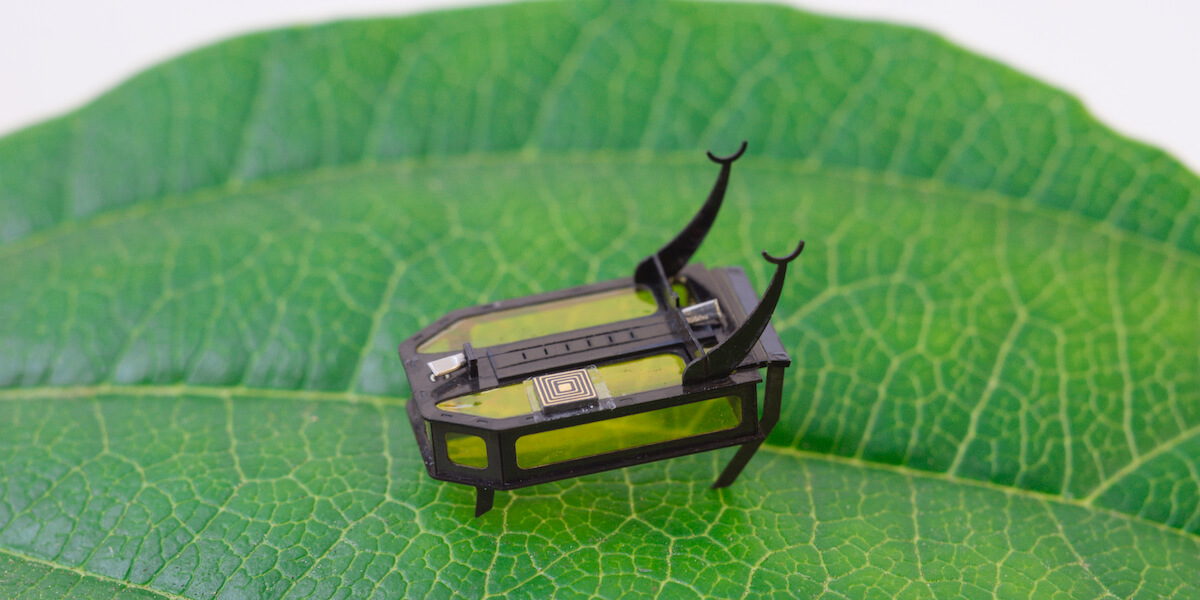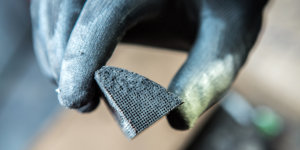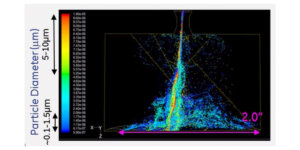
RoBeetle is the lightest and smallest fully autonomous crawling microrobot reported to date. PHOTO/ASML.
USC researchers from the Autonomous Microrobotic Systems Laboratory (AMSL) have created the lightest and smallest, fully autonomous crawling microrobot reported to date. RoBeetle weighs only 88 milligrams—approximately the equivalent mass of three grains of rice—and relies on a new type of actuator that functions as an artificial muscle.
The AMSL team is led by Néstor O. Pérez- Arancibia, assistant professor in the USC Viterbi School of Engineering’s Department of Aerospace and Mechanical Engineering, and Ph.D. candidates Xiufeng Yang and Longlong Chang. The research began over six years ago, motivated by the need of a further understanding of the relationships between energy density, power and autonomy—inspired by the energetics and biodynamics of insects. RoBeetle is actuated by a micro artificial muscle that transforms the chemical energy of fuels such as methanol, hydrogen, propane, or butane into mechanical work through a periodic process of controlled catalytic combustion. In this scheme, as the artificial muscle contracts and extends, a transmission mechanism maps the periodic actuation output into an anisotropic-friction-based crawling mode.
The research, funded by the National Science Foundation(NSF) and the Defense Advanced Research Projects Agency(DARPA), was published in Science Robotics.
RoBeetle from USC Viterbi on Vimeo.
2H Microactuaction
Yang, Chang, and Pérez-Arancibia refer to the technology that made the realization of the proposed artificial muscle as 2H, whose most salient characteristic is the combination of the high work density (HWD) associated with shape-memory alloy (SMA) materials with the capability of using sources of power with high energy densities (HEDs). The introduction of 2H actuation is a major breakthrough because, even though many impressive microrobots have been developed in the past 20 years, progress in terms of autonomy at the subgram scale has been hindered by the lack of microactuation methods with HWDs capable of using sources of power with HEDs.
Most microactuators currently available for robotic applications are driven electrically. However, the battery technology, in terms of energy density and power, required to drive systems at the scale of RoBeetle has yet to be developed, which explains why this robot is the first fully autonomous system at this scale (~100 milligrams), whereas all the other robots with similar weights remain tethered. This fact is easy to understand when we compare the energetics of batteries with those of the sources of power used by RoBeetle and insects. For example, the specific energy of the glucose and animal fat that power insects is about 20 times larger than that of the best subgram batteries currently available (about 38 versus 1.8 megajoules per kilogram); similarly, the specific energies of methanol and butane are more than 10 and 25 times as large as those of state-of-the-art batteries, respectively. In other words, battery technology is not a feasible path for subgram microrobots to achieve autonomy, whereas the approach put forward by the USC Viterbi researchers already achieved that goal.
Specifically, two key innovations enabled the realization of the artificial muscle used by RoBeetle. The first is a new technique for the fabrication of the composite wire at the core of the actuation mechanism, which is composed of an SMA Nitinol (NiTi) thin cylindrical nucleus and a coated surface of platinum (Pt) that acts as a catalyst for the combustion of fuel. The second is an electronics-free mechanical control mechanism (MCM) that simultaneously controls the chemical reaction on the catalytic surface of the NiTi-Pt composite wire and, as a consequence, drives the robot during operation.
Further Research and Applications
RoBeetle’s fuel-powered design may serve as a design paradigm for the creation of a new, diverse generation of autonomous microrobots capable of locomotion on land and in air and water. Furthermore, the proposed technology that combines catalytic-combustion-driven artificial muscles with mechanical control mechanisms can be employed to develop meter-scale robotic systems such as locomoting soft robots, hybrid exoskeletons and medical robots.
Pérez-Arancibia and his ASML graduate students have already combined the notion of controlled catalytic combustion with that of fast SMA actuation mechanism to develop fast catalytic artificial muscles. Pérez-Arancibia believes that this breakthrough will enable the creation of the very first, fully autonomous, subgram flying robot, which will be biologically inspired by butterflies.
Published on August 19th, 2020
Last updated on November 5th, 2020











